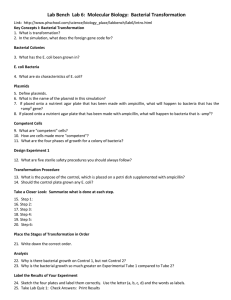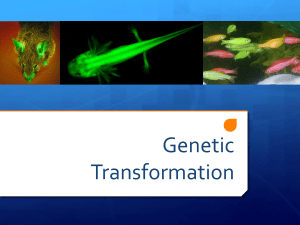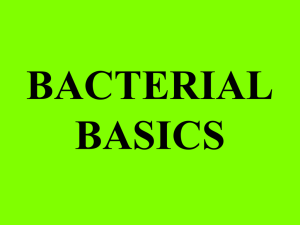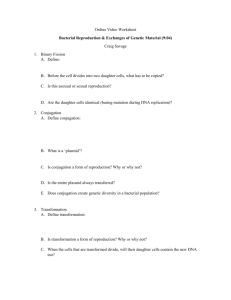Exp.9 Bacterial Transformation
advertisement
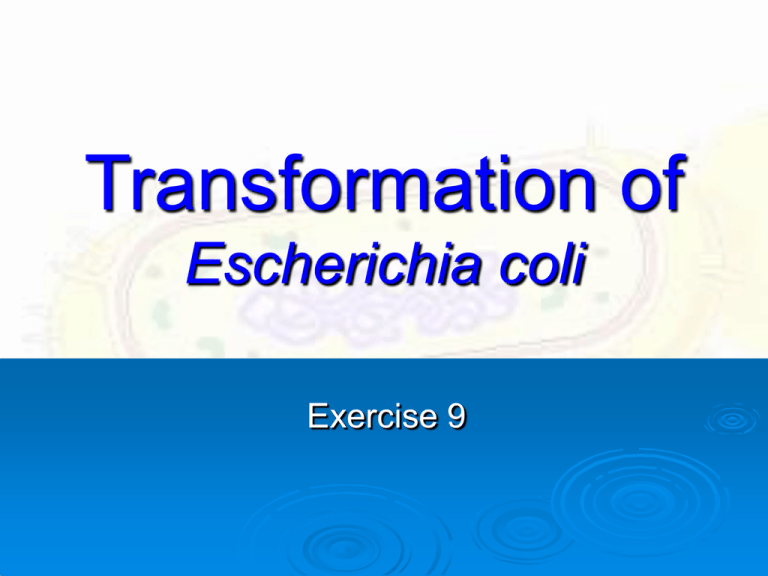
Transformation of Escherichia coli Exercise 9 Experiment Goals Understand the transformation procedure using the heat shock method. Understand how DNA can be transferred to an organism and the change in phenotype that may result from such a transfer. Transformation of a gene for resistance to the antibiotic ampicillin into a bacterial strain (E. Coli) that is sensitive to ampicillin. Bacterial Transformation Definition: Transformation is the genetic alteration of a cell resulting from the uptake and expression of foreign genetic material (DNA). i.e. the act of putting foreign DNA into a bacterial cell Occurs in nature, but rarely If the foreign DNA has an origin of replication recognized by the host cell DNA polymerases, the bacteria will replicate the foreign DNA along with their own DNA. Escherichia coli (E. coli) Lives in the human gut Relatively simple and well understood organism Its genetic material consists of: DNA 3-5 million base pairs in length, Plasmids, usually ranging from 5,000-10,000 base pairs in length It is these plasmids that bacteria can transfer back and forth, allowing them to share genes among one another and thus to naturally adapt to new environments. Plasmids Plasmids small circular extrachromosomal DNA Self-replicating DNA molecule separate from chromosome Plasmids Plasmid DNA usually contains genes for one or more traits that may be beneficial to bacterial survival. In nature, bacteria can transfer plasmids back and forth allowing them to share these beneficial genes. This natural mechanism allows bacteria to adapt to new environments. The occurrence of bacterial resistance to antibiotics is due to the transmission of plasmids. Transformation Applications How ? Use enzymes to cut plasmid DNA Insert a DNA sequence for a desired protein Insert plasmid into bacteria and grow…grows fast! Isolate protein made by bacteria Competency Not all bacteria take up free-floating DNA in the environment Bacteria which are able to uptake DNA are called "competent" Some bacterial strains have NATURAL COMPETENCE. Ex. Bacillus, Streptococcus, Haemophilus and Neisseria. Some bacterial strains, such as E. coli, can be made ARTIFICIALLY COMPETENT. Artificial Competency Since DNA is a very hydrophilic molecule, it won't normally pass through a bacterial cell's membrane. In order to make bacteria take in the plasmid, they must first be made "competent" to take up DNA. This is done by creating small holes in the bacterial cells by different methods. Cells that are undergoing very rapid growth are made competent more easily than cells in other stages of growth. Experiment In this experiment, we will introduce a gene for resistance to the antibiotic ampicillin into a bacterial strain that is sensitive to ampicillin If the sensitive bacteria incorporate the foreign DNA, they will become ampicillin resistant. Sterile Technique It is important not to contaminate E. Coli plates with external bacteria from hands or the table, etc The plates without ampicillin are especially prone to contamination, since anything can grow on those plates. Wearing gloves can help avoid contaminating plates and solutions Keep the lids on the plates whenever not adding things to the plates All of the solutions and plastic ware will be using have been sterilized Steps of Bacterial Transformation 1. 2. 3. 4. Competency Transformation Recovery period Growth & Isolation 1- Competency Label two sterile microtubes: one “+”and the other “-”. Using a disposable pipette, add 250 μl of 50mM CaCl2 solution to each tube (“+” and “-”) and place them both on ice. 1- Competency Use a sterile plastic loop to transfer one or two 3 mm bacterial colonies to the “+” tube, return tube to ice (Do not pick up an agar as it may inhibit the transformation process) Transfer a mass of cells to the “-” tube Add 10 µl of ampicillin resistant plasmid directly into the CaCl2 in “+” tube. Return the “+” tube to the ice. DO NOT add the plasmid to your "-" tube. Incubate both tubes on ice for 15 minutes. 1- Competency • Ca2+ neutralizes the negative charges on the phosphate backbone of the DNA, so that the DNA is not repulsed from the phospholipids of the cell membrane. • This allows the DNA to more easily pass 2- Transformation Insertion of a plasmid that contains a gene for the resistance to ampicillin Heat shock - helps plasmid enter the cells 2- Transformation 3- Recovery period Allow the cell to regain strength and start to multiply Necessary to allow expression of the antibiotic resistance gene on the plasmid Add 250 µl sterile Luria Broth to both tubes using a sterile pipette Move tubes to water bath at 37oC for 5 min. 4- Growth & Isolation Mark four Luria Broth agar plates Transformation procedure CaCl2 cold! E. coli Plasmid E. coli + pAmp 42oC Recover at 37oC LB + Amp Incubate at 37oC overnight LB + Amp E. coli 4- Growth & Isolation Transformation Efficiency After incubation count the colonies on each plate. Calculate the transformation efficiency Transformation Efficiency = no. of colonies observed/ µg Plasmid
